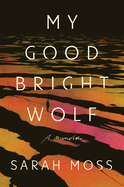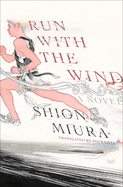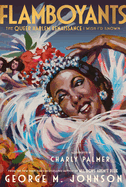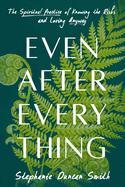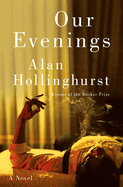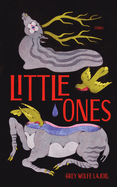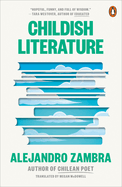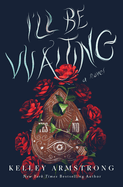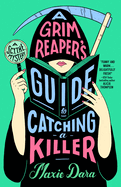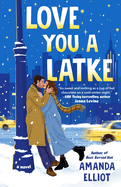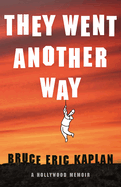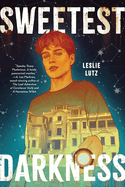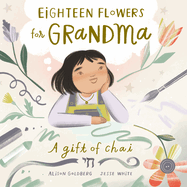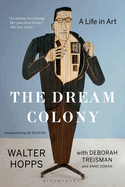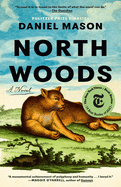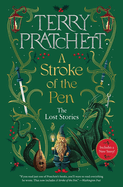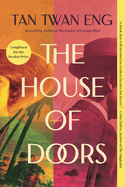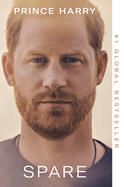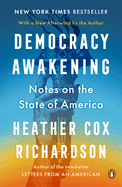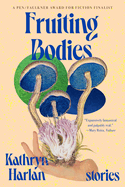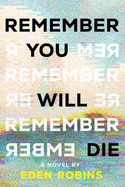Tuesday, October 22, 2024
Every year, the fall season arrives with an avalanche of books, and so for the next several weeks, Shelf Awareness will be spotlighting as many of our favorites as we can in newsletters delivered on both Tuesdays and Fridays! In today's issue, there's American Rapture by CJ Leede, an adrenaline rush of a horror novel about a virus that unleashes an insatiable--and fatal--lust in its victims; and My Good Bright Wolf by Sarah Moss, a rigorous, innovative memoir that rearranges fairy tale elements in order to better examine the author's experiences with disordered eating and the critical voices that have influenced her. Plus, Zachariah OHora's picture book Whalesong pays tribute to the special connection forged between a flautist and a pair of orcas in a true tale of compassion, animal rights, and the power of music.
For The Writer's Life, sci-fi/horror author Mason Coile discusses the chilling and thrilling books that shaped his imagination, including the "oh-so-many horror novels and thrillers I bought from the spinning drugstore rack in my hometown."
Run with the Wind
by Shion Miura, transl. by Yui Kajita
For a novel focused on the importance of running swiftly, Shion Miura's Run with the Wind is a leisurely--and deeply compassionate--narrative about gaining self-trust while solidifying lasting bonds. The book opens with a detailed drawing (by Akira Yamaguchi) facing the prologue page, titled "an illustration of Chikusei-so," a dilapidated college dorm at Kansei University. The exploded view of the two-story structure reveals occupied rooms displayed with the residents' names. As the story begins, though, the house is still waiting for its last and 10th inhabitant--and 10 is exactly the minimum number of members necessary to build a team eligible to enter the Hakone Ekiden, Japan's famed university relay marathon.
Kakeru isn't "just running, but running away." He's stolen a pastry (mahjong ate all his funds); even after outstripping the salesclerk, he's chased by Kiyose, pedaling hard on a bike. Kiyose presents a proposition: move into Chikusei-so, save money, and gain a running community with a purpose. In high school, Kakeru let his brash anger derail a promising track career; saying "yes" could be a chance at redemption. Chikusei-so's (mostly) amateurs might be underdogs, but together, they've got the opportunity to master some of life's best lessons--about hope, respect, strength, and worthy relationships.
Originally published in Japan in 2006 and since adapted for manga, anime, stage, and live-action film, Run with the Wind arrives Stateside deftly translated by literary scholar Yui Kajita, making her full-length translation debut. In any language, Miura is an easy writer to love--encouraging tenacity and championing kindness while imparting a most inspiring story. Team Miura for the win indeed! --Terry Hong
Discover: Shion Miura's Run with the Wind is all about racing--marvelously revealed at a gloriously leisurely pace to impart deep insights on tenacity, kindness, and nurturing true friendships.
Our Evenings
by Alan Hollinghurst
Fans of the great author Alan Hollinghurst (The Stranger's Child) will be delighted by Our Evenings, an elegant, episodic novel that spans half a century in the life of a gay, biracial British stage actor. The actor is David Win, the only child of a single mother. His father, whom David didn't know, was a Burmese man his mother met while working as a typist after World War II. At the start of the novel, David is in bed with his husband, Richard, when he learns upsetting news: Mark Hadlow, a wealthy businessman who, in the early 1960s, sponsored a scholarship for David to attend the elite Bampton school, has died at 94. That scholarship paved David's way to Oxford. It also introduced him to Mark's son, Giles, who would grow up to become a pro-Brexit right-winger, "one of our leading Eurosceptics."
Their lives intersect thereafter while also diverging wildly, with David becoming an actor of moderate renown. He remains close to his mother, a dressmaker, who enters into a business relationship, and more, with a divorcée named Esme Croft. The bulk of this graceful work dramatizes the peaks and valleys of David's life, including career successes and setbacks and his romantic partners--relations that, for a gay, dark-skinned man in Britain, raise more than a few eyebrows. The influence of Henry James on Hollinghurst's work is as pronounced as ever; he even winkingly slips in a Jamesian "hang fire." The edgy refinement of all of Hollinghurst's work is very much in evidence in this excellent book. --Michael Magras, freelance book reviewer
Discover: Our Evenings, a novel by Alan Hollinghurst, spans half a century in the life of David Win, a gay, biracial British actor, and charts his journey from scholarship student to actor of moderate renown.
Little Ones
by Grey Wolfe LaJoie
O. Henry Prize-winning writer Grey Wolfe LaJoie's debut collection, Little Ones, offers 21 bite-size works of fiction that find emotionally piercing stories in unexpected places. While each piece is ostensibly a short story, they reflect as wide a range of genres as they do characters, embracing such forms as the bureaucratic questionnaire in "Questions" and the Wikipedia entry in "Wiki." "Unfished, Unfinished," about an illustrator trying to illustrate, is a clever and psychedelic graphic take on the ars poetica. Meanwhile, even more "traditional" entries like "Ampersand Jansen" and "Interview with the Pope" demonstrate LaJoie's versatility through illustrations in a spectrum of artistic styles that complement their narrative tones.
While LaJoie's ability to slip into different formats and genres is part of what makes this collection refreshing, it's really their willingness to portray such a variety of points of view that make the stories themselves so memorable. "Mention of Flesh" might recount a nameless narrator's struggles to connect with their six-year-old daughter during difficult times, but "Frank" isn't afraid to take on the voice of a chorus of the dead recalling the experiences of a "road-killed raccoon." This range is emphasized by what sometimes feel like purposeful juxtapositions between stories, as with "Interview with the Pope" and the sloppily handwritten "Interview with Horsie," which, while necessarily funny, is also surprisingly heartrending. The ability for LaJoie's work to surprise readers with their emotional heft is never more the case than in "Delivery," in which a wandering dog brings out the best in the people it traverses between. Even among their humor, these stories touch tender spots as they explore underappreciated perspectives. --Alice Martin, freelance writer and editor
Discover: A wholly original collection of pieces from up-and-coming writer Grey Wolfe LaJoie, Little Ones delights and finds solace in the people, creatures, and spaces the world too often overlooks.
Childish Literature
by Alejandro Zambra, transl. by Megan McDowell
As familial relationships go, the one between fathers and sons has received inordinate attention throughout literature. Alejandro Zambra (Multiple Choice), a Chilean author based in Mexico, considers this dynamic in Childish Literature, translated from the Spanish by Megan McDowell. This excellent book collects essays, two stories, and a poem about father-son bonds. The essays focus on Zambra's relationships with his own father and with his young son. As Zambra writes, the term "children's literature" is condescending and redundant "because all literature, at its core, is childish," an observation meant as a compliment. He demonstrates that point in these pieces, starting with the titular work, a series of vignettes about his son's first year, when the baby is "relentlessly new."
Most of these pieces explore the joys and frustrations of that bond, all of it related in endearingly poetic prose. "French for Beginners" focuses on the boy's desire to read a French-language book about a mole. In "Screen Time," Zambra recalls how he and his wife surrendered to parental exhaustion and "lowered their standards and became habitual viewers of extremely mediocre series." "Blue-Eyed Muggers" tells parallel tales, one about Zambra's son's weekly phone calls with his grandfather and the other about the time 14-year-old Zambra rescued his father from robbers. And among the collection's two stories is "The Kid with No Dad," which portrays a friendship between two boys in Chile, one of whom does not know his father. Themes of memory, forgetting, and, most notably, the value of comfort permeate these exceptional works. --Michael Magras, freelance book reviewer
Discover: Alejandro Zambra's Childish Literature is an exceptional collection of essays, stories, and a poem about Zambra's transition to fatherhood and the inherent vagaries of the father-son dynamic.
Mystery & Thriller
I'll Be Waiting
by Kelley Armstrong
A séance goes horribly wrong when a grieving widow summons more than just her husband's spirit in I'll Be Waiting, a chilling horror novel from Kelley Armstrong. Armstrong (Disturbing the Dead; A Stranger in Town) is as versatile as she is prolific and uses her talent for developing pulse-pounding plots, immersive scenes, and compelling characters to craft a story that will make readers keep a light on.
Nicola Laughton defied the odds, surviving cystic fibrosis well into adulthood and finding her true love. Then a car crash takes Anton from her. Desperate to speak with him one last time, Nicola visits medium after medium, accomplishing nothing more than scaring her family. They agree to a final attempt: a séance with Dr. Cirillo, a parapsychologist and professor who will act as a medium. Together with Jin, Nicola's brother-in-law, and Shania, a friend from grief counseling, Nicola and the professor journey to the lake house where Nicola and her husband used to vacation.
The night the group arrives, a swarm of insects surrounds the house, effectively trapping them indoors. The longer Nicola and her companions are in the house, the harder it is to explain away the mysterious sounds, accidents, and connections to a horrible night more than two decades ago. What is Dr. Cirillo working on when no one is around? Whom can Nicola trust? And what are the sounds in the basement?
I'll Be Waiting is an excellent supernatural horror novel with a strong gothic feel. For anyone who loves staying up late with friends and a Ouija board, I'll Be Waiting is a terrifying treat. --Suzanne Krohn, librarian and freelance reviewer
Discover: A grieving widow gets more than she planned for when she attempts to summon her husband's spirit in this supernatural gothic horror novel.
A Grim Reaper's Guide to Catching a Killer
by Maxie Dara
While the traditional idea of a grim reaper doesn't bring the words "cozy" and "heartwarming" to mind, those are precisely the vibes Maxie Dara achieves with her debut novel. In A Grim Reaper's Guide to Catching a Killer, Kathy Valence wears sensible clothes and eats in the lunchroom as part of her daily work routine--it's just that her employer is S.C.Y.T.H.E. (Secure Collection, Yielding, and Transportation of Human Essences), and her job is transporting souls of the recently departed to a processing facility so they can move on to whatever afterlife awaits them.
Kathy is pregnant, mid-divorce, and very attached to her routine. Because she believes that she ruins everything she touches, it's important to her that her work remains uninteresting and ordinary. But that goes out the window when a routine collection gets disrupted by the undeniable absence of the soul itself and her subsequent discovery that this isn't a routine collection at all: the soul in question, Conner Ortiz, claims to have been murdered by a S.C.Y.T.H.E. employee. With only 45 days before Connor is doomed to become a ghost that will be trapped on Earth forever, Kathy is forced to rely on her mentor, Jo, and her maybe-ex-husband, Simon, to figure out what went wrong and what's really going on within S.C.Y.T.H.E.
Brimming with tense hijinks and sparkling humor, Dara's novel is an endearing, fun read about what it looks like to challenge damaging mental narratives that can hold one back from building a life of happiness and accepting--and reciprocating--love. --Kristen Coates, editor and freelance reviewer
Discover: Maxie Dara's endearing debut novel follows a modern-day grim reaper faced with solving a murder and allowing herself to accept the love she deserves.
Science Fiction & Fantasy
American Rapture
by CJ Leede
American Rapture, an adrenaline rush of a novel by award-winning horror writer CJ Leede (Maeve Fly), finds the Midwest ravaged by a strange new virus that infects people with insatiable--and fatal--lust. Sixteen-year-old Sophie has spent her entire life in a sheltered Catholic home. When the infection hits and her parents are among its early victims, Sophie is thrown into a hellish nightmare as she tries to reunite with her twin brother amid the chaos. But the more people she meets and the more she sees of a society that no longer conceals its animalistic impulses, the more Sophie wonders whether sexual desire is a curse or a vital part of life, too long denied.
Leede's blood-soaked, cross-country road trip is not for the faint of heart. Among all the ravenous "biting and licking and pulling and chewing" of the virus's victims are enough jump scares and gore to fulfill every horror fan's dreams. Although Leede never sacrifices an effective chase or thrilling fight sequence, she nevertheless seamlessly slips thought-provoking themes in alongside the novel's high-octane propulsion. Sophie's discovery of the world unfolds gradually, even as that world is exploding around her. The complex desires she fosters for multiple characters grapple convincingly with the sticky web of human sexuality. By the end of American Rapture, the seduction of its many pulse-pounding moments of intimacy is enough to tempt readers into considering themselves as infected as its characters. --Alice Martin, freelance writer and editor
Discover: A thrill-seeking, gore-loving joy ride, American Rapture is a speculative horror novel with big ideas that's as seductive as it is terrifying.
Romance
Love You a Latke
by Amanda Elliot
Amanda Elliot celebrates the winter holiday season with Love You a Latke, a heartwarming exploration of community and human connection set during Hanukkah.
When coffee shop owner Abby Cohen is steamrolled into organizing a Hanukkah festival in her small Vermont town, she has no idea where to start. Needing inspiration, she searches a dating app for other Jewish people in her area and discovers only Seth Abrams, the handsome but annoyingly optimistic customer who visits her shop every morning. Seth agrees to help, but in return, he asks Abby to pretend to be his girlfriend and spend Hanukkah at his parents' home in New York City. Abby, who grew up in the city but fled her childhood home and emotionally abusive parents several years ago, dreads the thought of returning but reluctantly agrees.
As she is immersed in activities with Seth's parents and friends, Abby is reminded how much she loves the holiday's traditions and misses being a part of a Jewish community. Additionally, their forced proximity compels Abby and Seth to confront their mutual attraction and individual insecurities. They both have habitually avoided confrontations by running away, but perhaps they can move beyond their chosen coping methods and build a future together.
This wonderful novel has a well-defined plot and characters with absorbing emotional depth. The story is set against the contrasting but equally vivid backdrops of New York City dressed in its holiday finery and charming small-town Vermont with its snowy landscape. Elliot's mouthwatering descriptions of latkes, doughnuts, and artisanal coffee will delight readers, as will the rest of her engaging novel. --Lois Faye Dyer, writer and reviewer
Discover: A coffee shop owner and her irritatingly charming customer join forces to take on matchmaking parents in this heartwarming story of love and community set during Hanukkah.
Biography & Memoir
My Good Bright Wolf: A Memoir
by Sarah Moss
Sarah Moss's rigorous, innovative memoir, My Good Bright Wolf, is about creating safety for a body embattled by disordered eating and competing voices.
As a novelist, Moss (Ghost Wall) exhibits compassionate attention and perspective--skills she applies autobiographically here. Her second- and third-person narration emphasizes the contrast between her thinking self and troublesome flesh. Growing up with an angry father (whom Moss calls "the Owl") and judgmental mother ("the Jumbly Girl") who praised her for losing weight, Moss knew she must stay small and never be high-strung. She adhered to an ever-stricter diet, yet her appetite for books remained voracious. Moss casts a critical eye over the literature of her childhood, which preached self-denial, encouraged independent exploration, and often depicted food in problematic ways. After eight years with anorexia, though, it seemed reading might prove Moss's salvation: Naomi Wolf's The Beauty Myth galvanized her to "change the world rather than your body."
However, the memoir constantly questions such easy conclusions. It bears privilege in mind, interrogates memories of abuse via an imagined critic ("If you believe this rubbish you're crazy and if you don't you're a liar"), and undermines rosy recovery narratives: a relapse landed Moss in the emergency room in midlife. Still, she is steadfast in the face of setbacks. The fairy tale wolf, stripped of its menace, is her familiar, a comforting messenger to her younger self. Feisty and original, this feminist text exhorts self and readers alike to "befriend your body." --Rebecca Foster, freelance reviewer, proofreader and blogger at Bookish Beck
Discover: Sarah Moss's innovative memoir spins a dark fairy tale from her history of disordered eating by interrogating the messages she absorbed from her parents and her childhood reading.
They Went Another Way: A Hollywood Memoir
by Bruce Eric Kaplan
For six months in 2022, Bruce Eric Kaplan (I Was a Child) was trying to bring his idea for a television show to fruition, but he kept getting the runaround, so he ended up doing a lot of nothing. Using a journal format, Kaplan lays out what happened--and what didn't--carefully, fretfully, and hilariously in They Went Another Way: A Hollywood Memoir.
With Glenn Close and Pete Davidson on board as the leads in Kaplan's intended show, he and his people started shopping the idea. Meetings--with his team, with studio honchos--were scheduled and then, as often as not, pushed back or canceled. In these pages, Kaplan reports on progress and setbacks, and because he has so much downtime while in waiting mode, he intersperses childhood memories, current events bulletins, home-repair updates, and news of the dead animals he keeps finding on his Los Angeles, Calif., property.
Kaplan, who is best known for his New Yorker cartoons, writes with the candor of one of his put-upon characters. In fact, many of his blunt, woeful sentences would work perfectly well as captions ("Is there any way my life could be turned into a musical about nothing ever happening and nothing ever getting fixed?"). His observational humor may conjure Seinfeld--no surprise, as Kaplan wrote for that show's final season--but he also evinces a devotion to his family that turns They Went Another Way into something more than a book about nothing. And yes, it would make a good television show. --Nell Beram, author and freelance writer
Discover: In Bruce Eric Kaplan's memoir about his effort to bring his idea for a television show to fruition, he lays out his progress and setbacks carefully, fretfully, and hilariously.
Social Science
The Anti-Ableist Manifesto: Smashing Stereotypes, Forging Change, and Building a Disability-Inclusive World
by Tiffany Yu
The Anti-Ableist Manifesto by Tiffany Yu gives readers a list of 33 ways to be actively anti-ableist, including "diversify your feed," "use your privilege," "hire us," and "nothing about us without us." Yu provides readers with the information they need to challenge the status quo and become better allies to the disabled community.
Yu, the founder and CEO of Diversability, a virtual disability-centered employee resource group, discusses simple actions, such as how to stop using ableist language, and more complex efforts, such as getting involved in local politics by attending community meetings and encouraging leaders to include disabled voices.
The book contains one chapter for each item in the manifesto, and Yu consults people with many kinds of disabilities for insight about what needs to be done and how, noting that disabled people are not a monolith. She includes statistics that strengthen her arguments. For example, there are 1.85 billion disabled people in the world, and "the disability market controls $13 trillion in disposable income." Why, Yu asks, wouldn't businesses want to cater to such a large group?
Each chapter ends with action items and reflection questions, giving readers space to absorb what they've just read. Interwoven through the book is the idea of universal design, the concept that a design that makes life easier for disabled people is likely to make life easier for everybody. Accessibility innovations such as curb cuts, electric toothbrushes, and automatic doors benefit nondisabled people, too.
Reflective, informative, and engaging, The Anti-Ableist Manifesto is an excellent choice for readers wanting to be better members of their community. --Alyssa Parssinen, freelance reviewer and former bookseller
Discover: Informative and engaging, The Anti-Ableist Manifesto provides 33 tangible ways readers can become actively anti-ableist and better allies to the disabled community.
Religion
Even After Everything: The Spiritual Practice of Knowing the Risks and Loving Anyway
by Stephanie Duncan Smith
Stephanie Duncan Smith's poignant, powerful debut memoir, Even After Everything, draws insightful parallels between the Christian liturgical year and Duncan Smith's own journey of pregnancy loss, new motherhood, and stubborn hope. As she navigates "hope in the after, hope against the grain of entirely reasonable fear," Duncan Smith explores the highs and lows of the Christian narrative, set into a calendar pattern that repeats every year, and invites believers to walk with her deeper into the story.
Recounting her path toward parenthood, Duncan Smith recalls the tender excitement of her first pregnancy and the sharp devastation of its end, which happened at Christmastime. She traces the terror and anticipation of carrying another child to term during a global pandemic and offers reflections on the life of Christ detailed in the church calendar and the "divine solidarity" of the Incarnation. For Duncan Smith, and for millions of believers over the centuries, the true miracle of faith is this "radical act of empathy embodied," which allows the divine to share in the deepest human experiences.
Duncan Smith writes honestly about the jarring moments when personal griefs scrape against moments of societal celebration, when "so much happens and so little makes sense." She looks grief in the face, but she also makes room for joy: her daughter's first laugh, the smell of strong coffee, the ancient and enduring powers of hope and love.
Full of beautiful questions, contemplations of living with uncertainty, and the raw courage it takes to move forward, Even After Everything offers wisdom and companionship to anyone who has taken the great risk of love after loss. --Katie Noah Gibson, blogger at Cakes, Tea and Dreams
Discover: Stephanie Duncan Smith's powerful debut memoir traces her journey of pregnancy loss and new motherhood alongside the Christian liturgical year.
Children's & Young Adult
Whalesong: The True Story of the Musician Who Talked to Orcas
by Zachariah OHora
Zachariah OHora's picture books Stop Snoring, Bernard! and No Fits, Nilson! center on animals and silliness. Whalesong: The True Story of the Musician Who Talked to Orcas centers on animals, minus the silliness, although OHora cushions his serious message with merriment in this true tale of compassion, animal rights, and the power of music.
In 1971, flutist Paul Horn and his two young sons liked to visit the two orcas at the aquarium near their home on British Columbia's Victoria Island. On one visit they encountered Dr. Paul Spong, who was playing recorded classical music in an effort to communicate with the whales. The next day, Paul Horn played his flute for the orcas, who seemed to move with the music; some days later, they were singing along ("Eeeeeeettttttsssshhhhhh!"). After one of the orcas died, the other was despondent until Paul's flute playing seemed to revive its spirits. The book's final spread declares that the two Pauls "helped people see how much orcas suffer in captivity" and that whales should be studied in the ocean, "where they belong."
Whalesong is written with a bubbly buoyancy (regarding Paul Horn's surname: "It's sort of funny that he prefers to play the flute!") and a hippie vibe that matches the book's early-1970s setting. OHora's digitally fine-tuned pencil-sketch art abounds with vibrant greens and sunflower yellow, and when bearded, tunic-wearing Paul and his kids aren't sitting cross-legged on the ground, they're dancing as if no one is watching. As conservation books for kids go, Whalesong may be the grooviest. --Nell Beram, freelance writer and YA author
Discover: Zachariah OHora cushions his serious message with merriment in this 1971-set picture book, a true tale of whales, compassion, animal rights, and the power of music.
Flamboyants: The Queer Harlem Renaissance I Wish I'd Known
by George M. Johnson, illus. by Charly Palmer
"Blackness is inherently queer," writes George M. Johnson (We Are Not Broken; All Boys Aren't Blue) in Flamboyants: The Queer Harlem Renaissance I Wish I'd Known, a triumphant and deeply personal illustrated essay collection that pays homage to 12 LGBTQ+ Black artists and the resounding impact they've made on future generations.
In refreshingly approachable language, Johnson highlights individuals from the prolific 1920s arts movement--including Langston Hughes, Zora Neale Hurston, and Ma Rainey--noting that many weren't public about their sexuality but expressed it through their art, "leaving us a road map for the future." The author's unapologetic perspective includes critiques, such as a discussion of Josephine Baker's apparent internalized homophobia, saying that "Fame doesn't always allow you to be who you are" and "it's okay to talk about people in their totality." Johnson emphasizes parts of the subjects' queer identities that were previously hidden, "suppressed or told inaccurately" and includes personal pieces, recounting feelings of rejection and confusion due to a lack of access to Black queer peoples' stories as a youth.
Each person from the queer Harlem Renaissance is captured in a stunning, brilliantly colored double-page illustration by Charly Palmer (The New Brownies' Book). Palmer's telltale bold brushstrokes and vivid hues depict the artists in close-up, with meaningful collaged items surrounding them. The images, much like the queer icons they depict, beg to be studied and proudly displayed. Flamboyants, through Johnson's dedicated research and devotion to their subjects, successfully demonstrates how "what was once done in silence and in the dark has moved toward the light." --Kieran Slattery, freelance reviewer, teacher, co-creator of Gender Inclusive Classrooms
Discover: This gorgeously illustrated, deeply personal essay collection celebrates how 12 queer Black artists and thinkers' works impacted future generations.
Sweetest Darkness
by Leslie Lutz
A teen clairvoyant accidentally unlocks a great evil and must stop it before it swallows everything he knows in this propulsive and unsettling YA horror novel set in a small Texas town.
Seventeen-year-old Quinn O'Brien is more than spooked when his older brother, Ollie, brings home a safe from the Alvarado, Gypsum's haunted hotel. Quinn, who has the ability to enter "the Dark Place," an intangible, veiled world where "bits of the future jumble through his mind," has repeatedly had a shared nightmare with his friends June and Selena about the hotel. Selling the antique safe is Ollie's latest "sure thing" to get the pair caught up on the mortgage that he is responsible for since their Gram died and left him the house. But strange visions instead compel Quinn to unlock it, and a man named Kit steps out, thanks Quinn, and walks away. In the days that follow, people go missing and constellations disappear from the sky. Quinn knows he must re-trap Kit--but he also knows that Kit can and will get into his head to stop him.
Sweetest Darkness by Leslie Lutz (Fractured Tide) is eerie and twisted. A magical atmosphere overlays the gorgeous rolling desert landscape where Quinn has grown up, his "first baby blanket" the Milky Way. Fleshing out the town's creepy vibe and Quinn's power are journal entries from the young adults' great-grandfathers recalling strange events, cursed film sets, and in-fighting. Lutz writes well-developed characters, especially Ollie, a deeply loving older brother trying hard to understand Quinn's burden. Quips nestle alongside tragic moments and frightening images, like gnashing, invisible teeth. This novel is at once disturbing and joyous. --Samantha Zaboski, freelance editor and reviewer
Discover: A teen clairvoyant accidentally unlocks a great evil and must stop it before it swallows everything he knows in this propulsive and unsettling small-town YA horror.
Eighteen Flowers for Grandma
by Alison Goldberg, illus. by Jesse White
Alison Goldberg (Bottle Tops) and Jesse White (Mabel Meets a Black Bear) have achieved a picture-book trifecta: Eighteen Flowers for Grandma is a stirring ode to intergenerational family bonds, a gentle introduction to a Jewish custom, and an up-close look at the artistic process.
It's "art day with Grandma" for Sadie: they work side by side at their easels in pursuit of what Grandma calls "creative inspiration." But for Grandma, art making is no leisure activity: today's painting is her last assignment before she graduates from college the following week. It's an occasion for which Sadie wants to give her "a special gift of chai"--the word means "life" in Hebrew--like the necklace that says "chai" that Grandma gave her when she graduated from kindergarten. Sadie's search for the perfect gift leads her to experiment artistically with a lilac blossom, "but there is something about this painting that just isn't Grandma enough." Will Sadie find creative inspiration in time for Grandma's graduation?
Sadie's art-making process ("She dips and prints, dips and prints," and so on) is captured both in the text and in White's elegant illustrations, which prioritize lilac, chartreuse, and vegetal greens and, per the book's back matter, incorporate the artist's "own take" on Jewish paper-cutting, a "traditional form of Jewish folk art... made by cutting figures and sentences from paper or parchment." It all adds up to a soothingly nutritive reading experience. Too bad Sadie can't give Grandma Eighteen Flowers for Grandma, a fine choice for anyone looking to give the gift of chai. --Nell Beram, freelance writer and YA author
Discover: A girl's quest for the perfect gift on the occasion of her grandmother's graduation from college drives this soothingly nutritive picture book, which introduces the Jewish custom of chai.
Now in Paperback
The Writer's Life
Reading with... Mason Coile
 |
|
| photo: Andrew Pyper | |
Mason Coile is the sci-fi/horror pseudonym for Andrew Pyper. Pyper is the author of 10 novels, including The Demonologist, which won the International Thriller Writers Award, and Lost Girls, which was a New York Times bestseller. Oracle, his audio-only thriller performed by Joshua Jackson, was a number one bestseller in the U.S. and the most listened to fiction audiobook in Canada the year of its release. William (Putnam), Coile's first novel, is part psychological horror, part cyber noir, a haunted house story in which the haunting is by AI.
Handsell readers your book in 25 words or less:
The story of a brilliant engineer who builds a DIY robot that self-identifies as the world's first AI demon. And who's to say it's wrong?
On your nightstand now:
I just finished my good friend Nick Cutter's new novel, The Queen, which contains some of the most inventive, detailed, gorgeously gross body horror you could ask for. Up next is On Writing and Failure by Stephen Marche (another friend), which surveys all the ways one can write and feel like a loser. Given the topic, it's an astonishingly short book.
Favorite book when you were a child:
I have little memory of there being many "books for children" around our house growing up, so I was reaching for the adult lit sooner than I likely should have (and certainly before I could fully understand it). So while it may not qualify as my favorite children's book, I would assign the Most Influential Book of My Youth Award to Stephen King's 'Salem's Lot. The town in King's novel was so much like my own, which made it way too easy to imagine the homes, schools, and streets outside my bedroom window seething with vampires. It terrified me and made me skittish as a racehorse. My mother forbade any more "scary stuff." Of course, her warnings were ignored. I was all in.
Your top five authors:
Margaret Atwood. Henry James. Stephen King. Martin Amis. Shirley Jackson.
Book you've faked reading:
Jane Austen's Emma saved me a lot of money I might have otherwise had to spend on sleeping pills in university, as every attempt to dig into it left me drowsy and distracted. For the exam I ended up watching the Gwyneth Paltrow movie and pretending I'd finished the book, all of which had the added side benefit of my falling into a deep crush on Gwynnie.
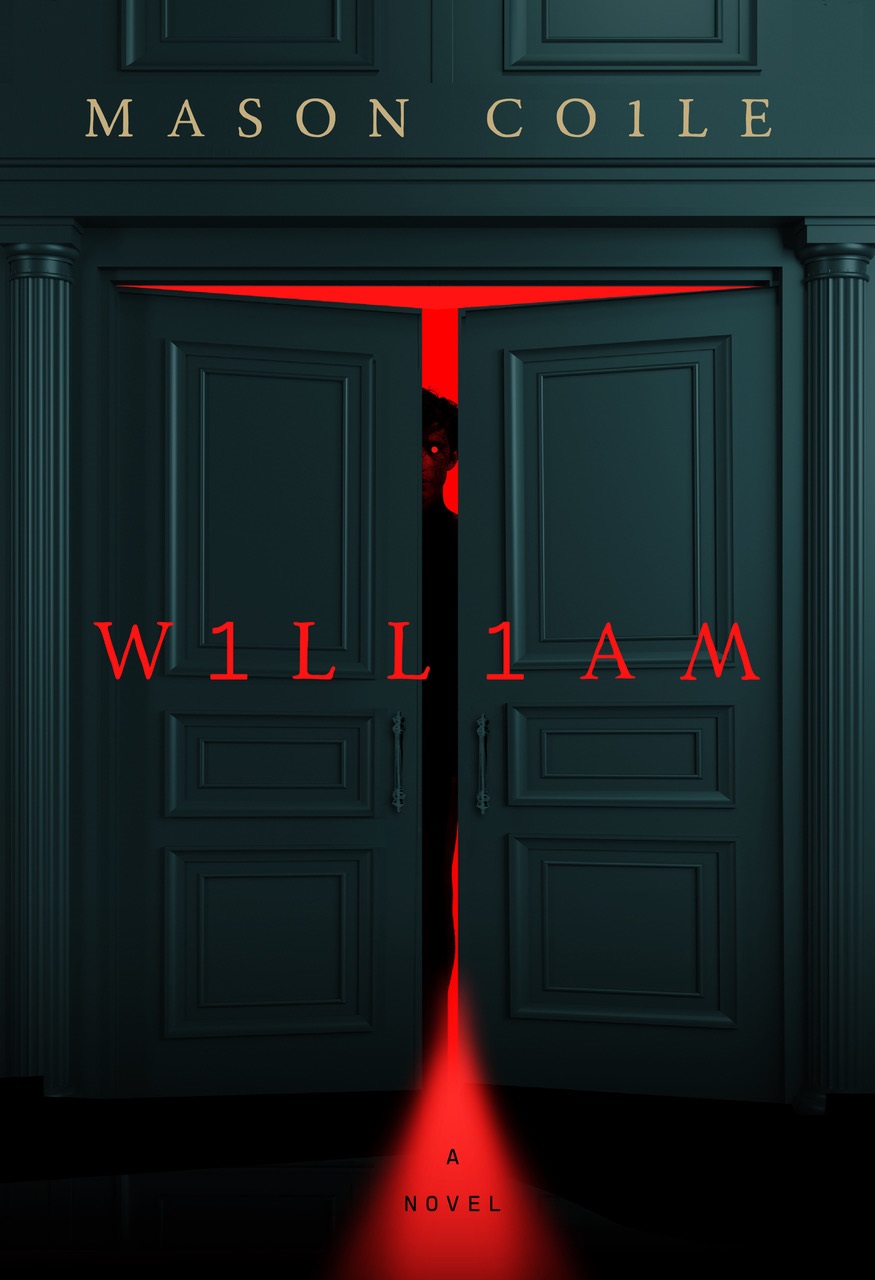 Book you're an evangelist for:
Book you're an evangelist for:
Come Closer by Sara Gran. A swift novel about demonic possession that shifts seamlessly from funny to suspenseful to horrific to heartbreaking. There are scenes that feel like terrible dreams invading the main character's reality--which the reader realizes (too late), are in fact dreams invading their own reality.
Book you've bought for the cover:
There are oh-so-many horror novels and thrillers I bought from the spinning drugstore rack in my hometown that were all about the lurid, sexy, irresistible covers. The Rats by James Herbert, Jaws by Peter Benchley, Hell House by Richard Matheson come to mind, though it's all a gold-foiled, pulpy blur.
Book you hid from your parents:
Flowers in the Attic by V.C. Andrews. It was famous among my schoolmates for the sex it contained, and famous among parents for the kind of sex it contained. Looking back on it, the thrill of hiding that book was probably more fun than actually reading it.
Book that changed your life:
I think they all have, in their ways (at least the good ones). But I will give the top honor to The Catcher in the Rye by J.D. Salinger. I know, I know. It's regarded as a little stale these days, and it's a common answer to this question for readers (mostly men?) of a certain age. But the truth is, it did blow me away when I first read it as a small-town adolescent with dreams of living an authentic, unconstrained life. The idea of being surrounded by fakes, of searching for selfhood while grappling with loneliness: the 13-year-old me was right there.
Favorite line from a book:
"All I kept thinking about, over and over, was 'You can't live forever; you can't live forever.' " --F. Scott Fitzgerald, The Great Gatsby
Five books you'll never part with:
My prized first editions. Joseph Conrad's Within the Tides. Henry James's The Europeans. Margaret Atwood's Cat's Eye (signed!). James Dickey's Deliverance. Andrew Pyper's Lost Girls (my first novel, forgive me).
Book you most want to read again for the first time:
This is a tough one! I'm going to say Peter Straub's Ghost Story. It opened my mind to the ways that horror could be literary and attentive to character and setting with the same effectiveness as delivering involving, deeply psychological scares.
Book Candy
Book Candy
Mental Floss investigates "Novella vs. Short Story: What's the Difference?"
---
The New York Public Library has acquired the archive of pioneering physician and bestselling author Oliver Sacks.
---
Kurt Vonnegut's lost, military-themed board game is finally for sale, Open Culture reported.
Remember You Will Die
by Eden Robins
Eden Robins (When Franny Stands Up) has written a smashingly good second novel, an utterly imaginative, genre-defying masterpiece: Remember You Will Die. Her blunt title is an accurate barometer that the end is nigh. In fact, the dead populate most of these pages. Their stories are revealed predominantly through obituaries that range from deeply soulful to delightfully guffaw-inducing. In between are occasional newspaper articles, lists, notes, word etymologies, and other ephemera that highlight death. Loosely, cleverly bound together, the narrative that emerges spotlights a singular mother/daughter relationship that will require 300 years of background to understand.
On November 6, 2102, an article appears in the New York Dispatch entitled "Mystery Surrounds Report of Girl Drowned in East River." According to an eyewitness to the watery plunge, the apparent action seems self-driven, complete with an alleged suicide note that was folded in the shape of an airplane and thrown toward the shore. Both paper and body remain missing. An anonymous call from a blocked number produces "the only concrete clue to the girl's identity": she was called Poppy.
Robins then inserts the first of multiple, fascinating etymologies. The word is, logically, "poppy": as plant ("flowers... with valuable narcotic properties"); as history ("the wanton brutality of the British Empire during the Opium Wars"); as symbolism ("of battlefields and war dead... possibly as far back as the time of Genghis Khan"). Robins also appends meaningful example sentences: "History wants poppy to be a symbol: of war, death, intoxication, resurrection. But poppy means only itself. Her needs are simple; she tilts her smiling face to the sun." These etymological interruptions are many; readers are encouraged to pay close attention to the wide-ranging background and usage of these singled-out words because prescient hints, clever asides, and a-ha revelations will be shared in each lexical intermission.
Two related obituaries follow. The first is a highly personal 1864 tribute for a 39-year-old floriographer devoted to roses--and divining young ladies' fortunes--who dies far too young on the battlefield. The second appears again in the New York Dispatch, 12 days after the opening article, and is the official obituary of Poppy Fletcher. Her "existence was little more than rumor," but her short life--a mere 17 years--is pieced together from scant details: "Her birth was unregistered, and no formal documentation has been discovered, no birth certificate or social security number, no school enrollment forms. Only a single photo of Poppy as a toddler, discovered in the cell phone of a deceased man who claimed to be a former neighbor, offers any physical evidence of her existence." One fact is certain: Poppy is the "sole offspring of the fugitive AI known as Peregrine," who was herself "a rogue science experiment" of computer scientist Matthew Fletcher, who was both Peregrine's "maker and 'consort.' "
In under a dozen pages, Robins establishes the central Peregrine/Poppy mother/daughter relationship. To tell their story, she deftly constructs a historical trail encompassing multiple centuries, conceives pioneering science, flags tragic dysfunctions and disconnects. If that's just the novel's very beginning, imagine what more Robins will concoct in the 300 pages that follow. One by one, each obituary comes closer to divulging the multi-layered origins of how Peregrine was created, how she defied her detractors, and manifested into a feeling, thinking, adaptable body able to create human life. Robins skillfully weaves together characters, relationships, events--dropping clues throughout via those slyly relevant etymologies (collapse, fathom, peach, latent, escape)--and makes the impossible believable.
Robins is a mischievous writer, detouring and distracting readers with mad scientists, performance artists, and fake deaths. Anne Frank survives to become an octogenarian, although her daughter (allegedly fathered by a priest) only made it to 42. Robins just as convincingly plays solemn soothsayer in contemplating fatal school shootings that continue decades into the future, Earth's ongoing destruction, the ruinous colonization of potential faraway alternatives. Tragedies loom, but humor--poignant, gentle, sardonic--is never far: a mortician goes by the online handle "the_decomposer"; a bar has the strippers sing and the customers strip; and the widow of the world's richest man has a "mycorrhizal network" experiment buried next to a McDonald's parking lot. Every inventive obituary is a connective micro-story of loss, grief, celebration, and regret, with surprising glimmers of hope.
So much happens. And eventually, it all makes satisfying, rewarding sense. Robins invites audiences along to experience the less-than-straightforward connectedness of humanity's past, present, and future. Time, alas, always proves fatal because "the only certainty is death, and the only other certainty is uncertainty." Yes, everyone dies, but Robins magnificently ensures their legacies linger. --Terry Hong
'What if All My Characters Were Dead?'
An Interview With Eden Robins
 |
|
| Eden Robins (photo: Jeff Kurysz) |
|
Chicago-based novelist Eden Robins first wrote about the power of laughter in the novel When Franny Stands Up, which landed her on numerous best-of-2022 lists. Humor also runs throughout her masterful stand-out sophomore novel, Remember You Will Die (Sourcebooks Landmark), even though it's populated mostly with dead people. By 2102, the so-called singularity--when computer intelligence surpasses that of humans--has long since happened and the AI known as Peregrine is about to learn her daughter Poppy has died. To unravel what happened will require a three-century excavation of relationships, cultures, science, history, and brilliantly executed etymology.
Help me out here: elevator pitch description?
It's a novel told entirely in obituaries, spanning 300 years, about grief and art and what it means to leave a legacy, and about humanity as seen through the eyes of an AI woman coping with loss.
Thank you! So what was that a-ha moment when you decided this is the book you wanted to write? How did you even start?
I feel like this book screams I WROTE IT IN THE PANDEMIC, and this is 100% true. I had just quit my job in either the best or worst timing, in March 2020. I immediately got stuck with writer's block--and terror, and grief, and uncertainty. I had no focus or attention span, I started and abandoned a bunch of new projects, but I found some solace in novels that were told in fragmented ways--like Jenny Offill's terrific Dept. of Speculation,which was my first clue.
Then I read an interview with Lynda Barry, cartoonist extraordinaire. She said that when she was writing her novel Cruddy, she was also stuck, and what got her out of it was writing the rough draft in paint, on yellow legal pads. So I got some acrylic paint, a tiny paintbrush, and some yellow legal pads and just started trying to sort through my brain on paper. It was remarkable because the slow pace meant I could really only think of one word at a time, and some amazing stuff came out. Not a draft of anything, just, you know, ideas. I think I set my unconscious mind up to think differently because one day I was doing nothing special, and this idea just popped into my head: What if I wrote a book of obituaries?
It sounded completely bonkers, so I decided to try. I watched the documentary Obit, about the New York Times obituary desk. They essentially get an assignment to write an obit, start to finish, in one day. So I decided that would be my process, too. I'd write whatever I felt like and figure out how it all fit together later.
And how did you know you'd be telling a story through dead people?
I really like to make my life hard. Also, I love a bit of mischief and trying something new. I thought, what if all my characters were dead? What if humanity was dying, and what if this wasn't, ultimately, a tragedy? I also decided I didn't want any standard narrative in the book. A fun challenge, but without a lot of precedents I could lean on for help!
And your Barry-inspired legal pad pages inspired the amazing etymological word-play and those slyly revealing example sentences.
Certainly, some of the words came from the paint-writing. But I also just love etymology. I have the Etymonline app on my phone. I see etymologies as a kind of archeology of humanity--they retain the feel of the original word in some way, even if they now mean something different. As for the example sentences--this became my little trick to squeeze in some narrative when I said I wouldn't have any.
You cover a good 300 years here, from the 19th to 22nd centuries. How did you do your past and future research?
I get a little obsessed with research. But it was a little easier here than in a regular novel because I only focused on things I was SUPER interested in, so going down a rabbit hole to learn about them was fun. I also only did one obit a day, so I could focus on a single topic, and I tried to build a whole world with a few key details. I tried to flesh out enough of the world to make sense and then left a bunch to the imagination.
I should also say that I have a friend who is a deep-sea biologist, and who has taken me to the bottom of the ocean in the Alvin submersible, so I got to use some of that fun stuff in the book. Basically a potpourri of everything I love and am interested in and like to think about got thrown in here. A dream!
In a book filled with death, you've intertwined at least as much humor. Your bio reveals you've written jokes professionally and done stand-up. How did you balance being respectful and getting the timing just right?
A lot of my past day jobs have revolved around using humor to engage and relax people while they're learning about complicated, emotional, or difficult things. I've learned so much from this work--really paying attention to people's moods and states of mind and using humor not as a distraction from but as an ingrained part of difficult conversations. Humor has always been an integral part of my writing because I don't see comedy as separate from drama, it's all a continuum.
Humor plays such a huge part in how we connect to each other, how we learn new things, and how we poke at power structures. I do think we sometimes think of humor as frivolous or unserious but that's such an unfortunate perspective because it is such a powerful tool.
You've woven the mother/child relationship throughout here. Did your own relationships inspire part of this writing?
I am not a mother, and I have just reached the cusp of life where being a biological mother is no longer possible for me. This is mostly fine, and mostly planned! But that cusp of life does really throw into relief the fact that mother/not-mother are two VERY divergent paths, and I've occasionally found myself a little wistful, which surprised me. I don't know what it's like to be a mother, but I did want to explore what that might feel like here. And even though the mother in this book is not human, I think that human motherhood must feel a little alien, too. It must feel strange to create a person who then becomes their own person, while you struggle with wanting to hold that person close and knowing you need to let go.
What's the one thing you want your audience to know before they read the book?
Oh, I'm terrible--I don't want to give any hints. I know it's very unpopular to care about spoilers these days, but I really want readers to unfurl the story at their own pace as they go, to pick up on the things that appeal to them, and to go back and discover other things in future reads. One thing I do want readers to know, though, is that, yes, the book is weird; no, they're not missing anything; and, yes, you can just kind of let it wash over you. That's all--there's no wrong way to read it. --Terry Hong
Rediscover
Rediscover: Robert Coover
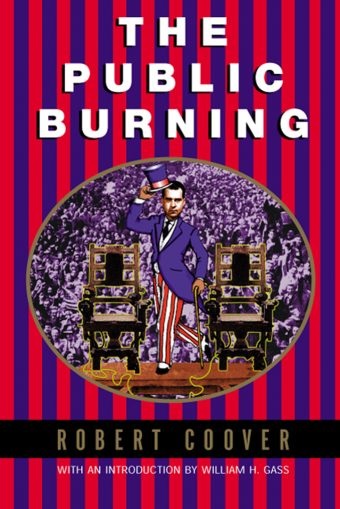 Robert Coover, "who along with Donald Barthelme, John Barth and others occupied the vanguard of postmodern American fiction in the 1960s and 1970s, and who went on to a long and prolific career writing and teaching," died October 5 at age 92, the New York Times reported.
Robert Coover, "who along with Donald Barthelme, John Barth and others occupied the vanguard of postmodern American fiction in the 1960s and 1970s, and who went on to a long and prolific career writing and teaching," died October 5 at age 92, the New York Times reported.
Coover's first novel, The Origin of the Brunists (1966), was fairly traditional in its telling, with Webster Schott writing in the New York Times Book Review: "If he can somehow control his Hollywood giganticism and focus his vision of life, he may become heir to Dreiser or Lewis."
But Pricksongs and Descants (1969), Coover's early story collection, made it clear he had no interest in inheriting the kingdom of social realism from Theodore Dreiser or Sinclair Lewis. "Those stories firmly established his career-long interest in remixing fairy tales, exploding myths and placing only the most transparent window in front of fiction's inner machinery," the Times noted.
In an interview with the New Yorker in 2014, Coover said, "I've engaged with folk tales and fairy tales all my writing life, as part of my attempted disruption of the myths that environ and sometimes govern us."
He targeted political myths in The Public Burning (1977), a novel reimagining the case of Julius and Ethel Rosenberg, and featuring other historical figures--Richard Nixon, J. Edgar Hoover--as well as two mythic characters, Uncle Sam and the Phantom, who represented the overheated rhetoric of Cold War antagonism.
Michiko Kakutani, former Times chief book critic, called Coover "probably the funniest and most malicious" of the postmodernists, "mixing up broad social and political satire with vaudeville turns, lewd pratfalls and clever word plays that make us rethink both the mechanics of the world and our relationship to it."
During his many years as a professor at Brown University, beginning in 1979, Coover's students included the authors Rick Moody, Joanna Scott, Jim Shepard, Sam Lipsyte, Ben Marcus, and Alexandra Kleeman. Coover would alternate a semester of teaching with two or three spent writing. Marcus, now a professor at Columbia University's MFA program, said Coover "thought tenure was death," and could be "a thorn in the side of the lifers."
Lipsyte, who also now teaches at Columbia, studied with Coover as an undergraduate. "He was very much aware of his position as a part of that postmodern movement that was breaking away from American tradition in the novel," he said. "That was a big part of his teaching--to expand our mind and make us think about new modes and new approaches" and "to knock us into new places."
In a 1992 column in the Times titled "The End of Books," Coover wrote that he was "interested as ever in the subversion of the traditional bourgeois novel and in fictions that challenge linearity."
Elected to the American Academy of Arts and Letters in 1987, Coover was prolific and ambitious into late life. In 2014, he published The Brunist Day of Wrath, a thousand-page sequel to his debut novel. Huck Out West (2017) imagined Huck Finn and Tom Sawyer in the Wild West.
In recent years, he continued to publish stories in the New Yorker, and released two collections of fairy tale-influenced books through McSweeney's: A Child Again (2005) and Stepmother (2004). In 2021, he published Street Cop, a short novel with illustrations by Art Spiegelman. His other books include The Universal Baseball Association, J. Henry Waugh, Prop. (1968), Gerald's Party (1985), and John's Wife (1996).
"There's nothing necessarily wrong with myths," Coover said in a 2011 interview with the New Statesman. "We tend to need some sort of sustaining mythic notion or pattern or vision in order to get through each day. We need a little bit of structure to get out of bed, to keep going. But most of it is stifling, in some way corrupting."
| Advertisement Meet belle bear! |



